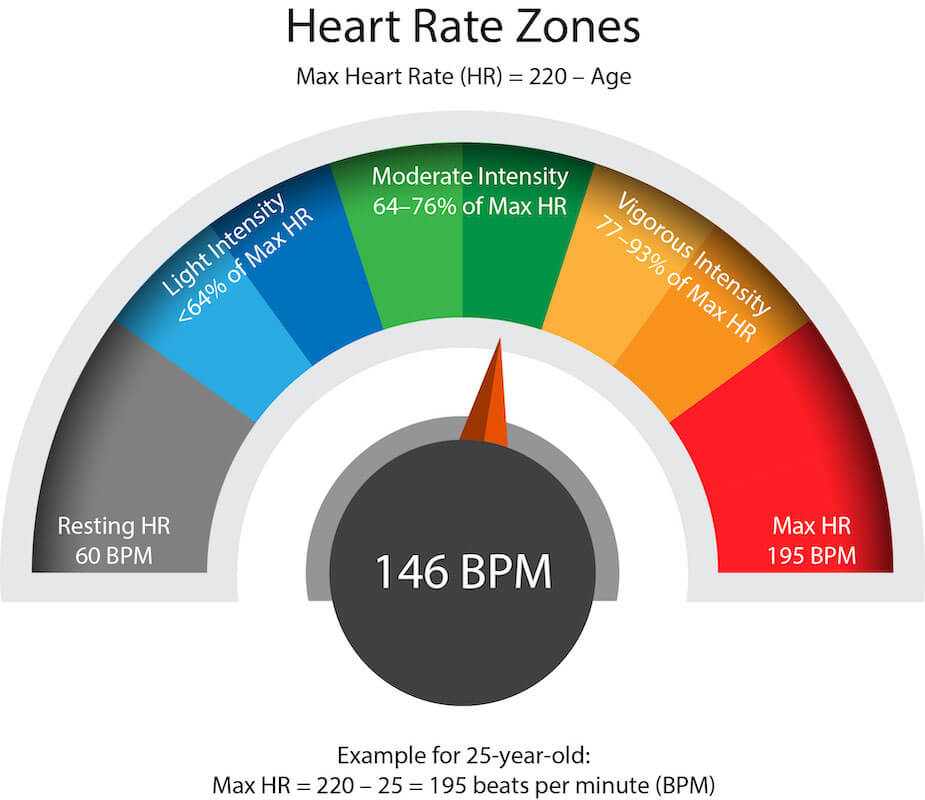Simple And Accurate Ways To Determine Your Heart Rate Zone

Ensuring that your heart rate is in the zone during your runs will help gauge your endurance and help you stay in the peak fat-burning zone for weight loss.
Your smartwatch displays your heart rate training zones, but what do those numbers even mean? Is a heart rate of 130 ideal for weight loss? Is it good or bad? Should you be aiming higher or lower? What should be your target heart rate zone?
Determining Your Heart Rate Zone
Maximum heart rates (MHR) are different for everyone. A quick way to determine your maximum heart rate is to subtract your age from 220. If you are 30 years old, for instance, your math should look a little something like this:
220 – 30 =190 Max Heart Rate
If you want to train at 50 percent of your max heart rate, multiply the percentage by your max heart rate like this:
190 x .5 (50 percent) = 95 BPM
Surprisingly, working out near your max heart rate isn’t always ideal, especially for weight loss. When your heart pumps faster at 90 percent of your max, it means that you aren’t burning quickly or efficiently. You will burn calories quicker when closer to your maximum, but only 45 percent of calories burned are from fat.
When you work out at 60 percent of your max, an impressive 65 percent of calories burned are from fat.
So, what are the different heart rate zones, and what works best for your running goals and your fitness level?
5 Heart Rate Zones You Should Know About
Zone 1
This anaerobic zone is used primarily for warm-ups and cool-downs. It’s just a step above your resting heart rate (when you do absolutely nothing.)
Many runners tell you that a 5-minute warm-up is enough to get your body ready for a run, but that may not be true for everyone. Using a targeted heart rate rather than a simple measurement of time is the best tool to get ready for a workout.
Zone 1 is typically between 50-60 percent of your max heart rate. If your max heart rate is 190, this means that for a warm-up or cool-down, you should shoot for around 95 BPM.
Zone 2
Ah yes, the elusive Zone 2. This zone is the aerobic sweet spot where the fat comes to die. When running in Zone 2, roughly 65 percent of calories burned come from fat. It’s a little harder to reach because just as you hit this sweet spot, it continues to climb higher as you run or increase exercise intensity.
Once runners hit zone 2, many athletes find that they need to pull back on the reigns and slow their pace to a walk to keep it comfortably in this zone. It’s challenging for runners with lower endurance, but the more your train, the easier it will become to keep your heart in the zone!
Zone 3
While Zone 2 is built for fat-burning, Zone 3 is perfect for building endurance and strength at a moderate-intensity heart rate. Your heart is pumping at around 75 percent of its maximum capacity. Training in Zone 3 will help boost your V02 max, which helps increase your endurance.
You won’t burn as much fat as Zone 2, but increased endurance will make it slightly easier to exercise for more extended periods, which is excellent news for long-distance runners.
Zone 4
Zone 4 is the “Race Pace” and clocks in at around 80 percent of your max heart rate. You will increase your cardio endurance and build lean muscles at this grueling pace. While this pace technically burns more calories than Zone 1-3, it doesn’t burn as much fat.
Overall, Zone 4 burns 45 percent fat and reaches for glucose reserves for fuel. If you want to build speed and endurance, training even in short 5-minute bursts in Zone 4 is the way to go.
Zone 5
Zone 5 clocks in at 90 percent or more of your max heart rate. Overall, you can only maintain this pace for short bursts of time. In Zone 5, your legs are burning, and you will find it difficult to speak.
It’s primarily used in HIIT, where you swing between insanely high intensity physical activity for around 30 seconds and then lower your heart rate back down to Zone 3.
HIIT training allows you to burn many calories in a short amount of time while burning fat, building muscle, and increasing your overall endurance.

What Zone is Best For Weight Loss?
If your ultimate fitness goal is to lose weight, aiming for Zone 2 is the best way to melt all of that excess fat right off your body! The harder your heart pumps, the more calories you will burn – but that doesn’t mean that Zone 5 translates to peak weight loss.
You burn more calories in Zone 5, but those calories don’t always come from fat.
When running in Zone 2, around 65 percent of the calories burned are derived from stored fat.
Zone 2 is a little harder to maintain, but with practice and diligent training, it becomes a bit easier with time.
Invest in a Heart Rate Monitor or Smartwatch
Without a smartwatch or a fitness tracker, you can still calculate your heart rate range and the number of heart beats, but it will be a little time-consuming. Place your forefinger and middle finger (never your thumb) on your wrist or neck to find your pulse.
Set a timer for 30 seconds, and count how many times your heart pumps within that period. To calculate how many times it beats per minute, multiply that number by 2.
While you can measure your heart rate without a watch, it demands that you stop what you are doing to make your calculations. A smartwatch immediately detects your heart rate, and many are incredibly accurate.
Latest Articles
 Is Running on a Treadmill Easier Than Running Outside?Runners have their own preferences, whether it is treadmill running, running outside on the road, or exploring trails. So...
Is Running on a Treadmill Easier Than Running Outside?Runners have their own preferences, whether it is treadmill running, running outside on the road, or exploring trails. So... Is It OK to Use Trail Running Shoes on the Road?While trail running shoes can be used on roads, especially in situations where a runner encounters mixed terrains or pref...
Is It OK to Use Trail Running Shoes on the Road?While trail running shoes can be used on roads, especially in situations where a runner encounters mixed terrains or pref... How to Fix Sore Quads After Running?Rest, ice, gentle stretching, and over-the-counter pain relievers can help soothe sore quads after running. Also, ensure ...
How to Fix Sore Quads After Running?Rest, ice, gentle stretching, and over-the-counter pain relievers can help soothe sore quads after running. Also, ensure ... 10 Fruits With The Most Electrolytes to Replace Sports DrinksThese fruits are high in electrolytes such as potassium, magnesium, and calcium, essential for hydration, muscle function...
10 Fruits With The Most Electrolytes to Replace Sports DrinksThese fruits are high in electrolytes such as potassium, magnesium, and calcium, essential for hydration, muscle function...

